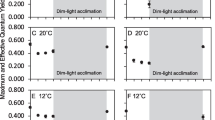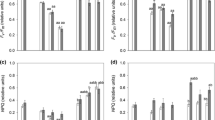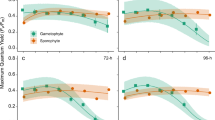Abstract
Main conclusion
Desiccation-induced chlorophyll fluorescence quenching seems to be an indispensable part of desiccation resistance in the surveyed 28 green microalgal species.
Lichens are desiccation tolerant meta-organisms. In the desiccated state photosynthesis is inhibited rendering the photobionts potentially sensitive to photoinhibition. As a photoprotective mechanism, strong non-radiative dissipation of absorbed light leading to quenching of chlorophyll fluorescence has been proposed. Desiccation-induced quenching affects not only variable fluorescence, but also the so-called basal fluorescence, F0. This phenomenon is well-known for intact lichens and some free living aero-terrestrial algae, but it was often absent in isolated lichen algae. Therefore, a thorough screening for the appearance of desiccation-induced quenching was undertaken with 13 different aero-terrestrial microalgal species and lichen photobionts. They were compared with 15 aquatic green microalgal species, among them also three marine species. We asked the following questions: Do isolated lichen algae show desiccation-induced quenching? Are aero-terrestrial algae different in this respect to aquatic algae and is the potential for desiccation-induced quenching coupled to desiccation tolerance? How variable is desiccation-induced quenching among species? Most of the aero-terrestrial algae, including all lichen photobionts, showed desiccation-induced quenching, although highly variable in extent, whereas most of the aquatic algae did not. All algae displaying quenching were also desiccation tolerant, whereas all algae unable to perform desiccation-induced quenching were desiccation intolerant. Desiccation-induced fluorescence quenching seems to be an indispensable part of desiccation resistance in the investigated species.





Similar content being viewed by others
Abbreviations
- qdes :
-
Desiccation-induced chlorophyll fluorescence quenching
- r.h.:
-
Relative air humidity
- SAG:
-
Culture Collection of Algae at the University of Göttingen, Catalogue Number
References
Alpert P (2005) The limits and frontiers of desiccation-tolerant life. Integr Comp Biol 45:685–695
Alpert P (2006) Constraints of tolerance: why are desiccation-tolerant organisms so small or rare? J Exp Biol 209:1575–1584. https://doi.org/10.1242/jeb.02179
Barták M, Hájek J, Gloser J (2000) Heterogeneity of chlorophyll fluorescence over thalli of several foliose macrolichens exposed to adverse environmental factors: interspecific differences as related to thallus hydration and high irradiance. Photosynthetica 38:531–537. https://doi.org/10.1023/A:1012405306648
Bilger W (2014) Desiccation-induced quenching of chlorophyll fluorescence in cryptogams. In: Demmig-Adams B, Garab G, Adams WA III, Govindjee (eds) Non-photochemical quenching and energy dissipation in plants, algae and cyanobacteria. Springer Netherlands, Dordrecht, pp 409–420
Bowler MG, Bowler DR, Bowler MW (2017) Raoult’s law revisited: accurately predicting equilibrium relative humidity points for humidity control experiments. J Appl Crystallogr 50:631–638
Carniel F, Zanelli D, Bertuzzi S, Tretiach M (2015) Desiccation tolerance and lichenization: a case study with the aeroterrestrial microalga Trebouxia sp. (Chlorophyta). Planta 242:493–505. https://doi.org/10.1007/s00425-015-2319-z
del Hoyo A, Álvarez R, del Campo EM, Gasulla F, Barreno E, Casano LM (2010) Oxidative stress induces distinct physiological responses in the two Trebouxia phycobionts of the lichen Ramalina farinacea. Ann Bot 107:109–118. https://doi.org/10.1093/aob/mcq206 [print version in Ann Bot 2011; epub 2010 provided by doi]
Deltoro VI, Calatayud A, Gimeno C, Barreno E (1998) Water relations, chlorophyll fluorescence, and membrane permeability during desiccation in bryophytes from xeric, mesic, and hydric environments. Can J Bot 76:1923–1929. https://doi.org/10.1139/b98-167
DePriest PT (2004) Early molecular investigations of lichen-forming symbionts: 1986–2001. Annu Rev Microbiol 58:273–301. https://doi.org/10.1146/annurev.micro.58.030603.123730
Dietz S, Büdel B, Lange O, Bilger W (2000) Transmittance of light through the cortex of lichens from contrasting habitats. In: Schroeter B, Schlensorg M, Green TGA (eds) New aspects in cryptogamic research: contribution in honour of Ludger Kappen. Bibliotheca Lichenologica 75:171–182
Gasulla F, de Nova PG, Esteban-Carrasco A, Zapata JM, Barreno E, Guera A (2009) Dehydration rate and time of desiccation affect recovery of the lichenic algae Trebouxia erici: alternative and classical protective mechanisms. Planta 231:195–208. https://doi.org/10.1007/s00425-009-1019-y
Gasulla F, Jain R, Barreno E et al (2013) The response of Asterochloris erici (Ahmadjian) Skaloud et Peksa to desiccation: a proteomic approach. Plant, Cell Environ 36:1363–1378
Gauslaa Y, Solhaug KA (2004) Photoinhibition in lichens depends on cortical characteristics and hydration. Lichenol 36:133–143. https://doi.org/10.1017/S0024282904014045
Gauslaa Y, Solhaug KA, Longinotti S (2017) Functional traits prolonging photosynthetically active periods in epiphytic cephalolichens during desiccation. Environ Exp Bot 141:83–91. https://doi.org/10.1016/j.envexpbot.2017.07.005
Green TGA, Proctor MCF (2016) Physiology of photosynthetic organisms within biological soil crusts: their adaptation, flexibility, and plasticity. In: Weber B, Büdel B, Belnap J (eds) Biological soil crusts: an organizing principle in drylands. Springer International Publishing, Berlin, pp 347–381
Green TGA, Kilian E, Lange OL (1991) Pseudocyphellaria dissimilis: a desiccation-sensitive, highly shade-adapted lichen from New Zealand. Oecologia 85:498–503. https://doi.org/10.1007/BF00323761
Heber U (2008) Photoprotection of green plants: a mechanism of ultra-fast thermal energy dissipation in desiccated lichens. Planta 228:641–650. https://doi.org/10.1007/s00425-008-0766-5
Heber U, Bilger W, Bligny R, Lange OL (2000) Phototolerance of lichens, mosses and higher plants in an alpine environment: analysis of photoreactions. Planta 211:770–780. https://doi.org/10.1007/s004250000356
Heber U, Bukhov NG, Shuvalov VA, Kobayashi Y, Lange OL (2001) Protection of the photosynthetic apparatus against damage by excessive illumination in homoiohydric leaves and poikilohydric mosses and lichens. J Exp Bot 52:1999–2006
Heber U, Bilger W, Shuvalov VA (2006a) Thermal energy dissipation in reaction centres and in the antenna of photosystem II protects desiccated poikilohydric mosses against photo-oxidation. J Exp Bot 57:2993–3006
Heber U, Lange OL, Shuvalov VA (2006b) Conservation and dissipation of light energy as complementary processes: homoiohydric and poikilohydric autotrophs. J Exp Bot 57:1211–1223
Heber U, Azarkovich M, Shuvalov V (2007) Activation of mechanisms of photoprotection by desiccation and by light: poikilohydric photoautotrophs. J Exp Bot 58:2745–2759
Heber U, Bilger W, Türk R, Lange OL (2010) Photoprotection of reaction centres in photosynthetic organisms: mechanisms of thermal energy dissipation in desiccated thalli of the lichen Lobaria pulmonaria. New Phytol 185:459–470. https://doi.org/10.1111/j.1469-8137.2009.03064.x
Hoekstra FA, Golovina EA, Buitink J (2001) Mechanisms of plant desiccation tolerance. Trends Plant Sci 6:431–438
Holzinger A, Karsten U (2013) Desiccation stress and tolerance in green algae: consequences for ultrastructure, physiological and molecular mechanisms. Front Plant Sci. https://doi.org/10.3389/fpls.2013.00327
Holzinger A, Tschaikner A, Remias D (2010) Cytoarchitecture of the desiccation-tolerant green alga Zygogonium ericetorum. Protoplasma 243:15–24. https://doi.org/10.1007/s00709-009-0048-5
Holzinger A, Lütz C, Karsten U (2011) Desiccation stress causes structural and ultrastructural alterations in the aeroterrestrial green alga Klebsormidium crenulatum (Klebsormidiophyceae, Streptophyta) isolated from an alpine soil crust. J Phycol 47:591–602
Karsten U, Holzinger A (2012) Light, temperature, and desiccation effects on photosynthetic activity, and drought-induced ultrastructural changes in the green alga Klebsormidium dissectum (Streptophyta) from a high alpine soil crust. Microb Ecol 63:51–63
Karsten U, Herburger K, Holzinger A (2014) Dehydration, temperature and light tolerance in members of the aeroterrestrial green algal genus Interfilum (Streptophyta) from biogeographically different temperate soils. J Phycol 50:804–816
Komura M, Yamagishi A, Shibata Y et al (2010) Mechanism of strong quenching of photosystem II chlorophyll fluorescence under drought stress in a lichen, Physciella melanchla, studied by subpicosecond fluorescence spectroscopy. Biochim Biophys Acta BBA Bioenerg 1797:331–338. https://doi.org/10.1016/j.bbabio.2009.11.007
Kosugi M, Arita M, Shizuma R, Moriyama Y, Kashino Y, Satoh K (2009) Responses to desiccation stress in lichens are different from those in their photobionts. Plant Cell Physiol 50:879–888
Kosugi M, Miyake H, Yamakawa H, Shibata Y, Miazawa A, Sugimura T, Satoh K, Itoh S, Kashino Y (2013) Arabitol provided by lichenous fungi enhances ability to dissipate excess light energy in a symbiotic green alga under desiccation. Plant Cell Physiol 54:1316–1325
Kranner I, Zorn M, Turk B, Wornik S, Beckett RP, Batic F (2003) Biochemical traits of lichens differing in relative desiccation tolerance. New Phytol 160:167–176. https://doi.org/10.1046/j.1469-8137.2003.00852.x
Kranner I, Cram WJ, Zorn M, Wornik S, Yoshimura I, Stabentheiner E, Pfeifhofer HW (2005) Antioxidants and photoprotection in a lichen as compared with its isolated symbiotic partners. Proc Natl Acad Sci USA 102:3141–3146
Kranner I, Beckett R, Hochman A, Nash TH (2008) Desiccation-tolerance in lichens: a review. Bryol 111:576–593. https://doi.org/10.1639/0007-2745-111.4.576
Krause GH, Jahns P (2004) Non-photochemical energy dissipation determined by chlorophyll fluorescence quenching: characterization and function. In: Papageorgiou GC, Govindjee (eds) Chlorophyll a fluorescence: a signature of photosynthesis. Springer Netherlands, Dordrecht, pp 463–495
Lange O, Kilian E (1985) Reaktivierung der Photosynthese trockener Flechten durch Wasserdampfaufnahme aus dem Luftraum: Artspezifisch unterschiedliches Verhalten. Flora 176:7–23
Lange OL, Bilger W, Rimke S, Schreiber U (1989) Chlorophyll fluorescence of lichens containing green and blue-green algae during hydration by water vapor uptake and by addition of liquid water. Bot Acta 102:306–313. https://doi.org/10.1111/j.1438-8677.1989.tb00110.x
Maksimov E, Schmitt F-J, Tsoraev G et al (2014) Fluorescence quenching in the lichen Peltigera aphthosa due to desiccation. Plant Physiol Biochem 81:67–73
Miyake H, Komura M, Itoh S, Kosugi M, Kashino Y, Satoh K, Shibata Y (2011) Multiple dissipation components of excess light energy in dry lichen revealed by ultrafast fluorescence study at 5 K. Photosynth Res 110:39–48. https://doi.org/10.1007/s11120-011-9691-8
Nishiyama Y, Allakhverdiev SI, Murata N (2011) Protein synthesis is the primary target of reactive oxygen species in the photoinhibition of photosystem II. Physiol Plant 142:35–46. https://doi.org/10.1111/j.1399-3054.2011.01457.x
Osmond C (1994) What is photoinhibition? Some insights from comparisons of shade and sun plants. In: Baker NR, Bowyer JR (eds) Photoinhibition of photosynthesis from molecular mechanisms to the field. Bios Scientific Publishers, Oxford, pp 1–24
Pichrtová M, Kulichova J, Holzinger A (2014) Nitrogen limitation and slow drying induce desiccation tolerance in conjugating green algae (Zygnematophyceae, Streptophyta) from polar habitats. PLoS One. https://doi.org/10.1371/journal.pone.0113137
Potts M (1994) Desiccation tolerance of prokaryotes. Microbiol Rev 58:755–805
Potts M (2001) Desiccation tolerance: a simple process? Trends Microbiol 9:553–559. https://doi.org/10.1016/S0966-842X(01)02231-4
Potts M, Slaughter SM, Hunneke F-U, Garst JF, Helm RF (2005) Desiccation tolerance of prokaryotes: application of principles to human cells. Integr Comp Biol 45:800–809
Proctor MCF, Oliver MJ, Wood AJ, Alpert P, Stark LR, Cleavitt NL, Mishler BD (2007) Desiccation-tolerance in bryophytes: a review. Bryol 110:595–621. doi:10.1639/0007-2745(2007)110[595:dibar]2.0.co;2
Raanan H, Oren N, Treves H et al (2016) Towards clarifying what distinguishes cyanobacteria able to resurrect after desiccation from those that cannot: the photosynthetic aspect. Biochim Biophys Acta BBA Bioenerg 1857:715–722
SAG Database (2017) http://sagdb.uni-goettingen.de/index.php. Accessed 24 Aug 2017
Sancho LG, Belnap J, Colesie C, Raggio J, Weber B (2016) Carbon budgets of biological soil crusts at micro-, meso-, and global scales. In: Weber B, Büdel B, Belnap J (eds) Biological soil crusts: an organizing principle in drylands. Springer International Publishing, Berlin, pp 287–304
Scheibe R, Beck E (2011) Drought, desiccation, and oxidative stress. In: Lüttge U, Beck E, Bartels D (eds) Plant desiccation tolerance. Springer, Berlin, pp 209–231
Slavov C, Reus M, Holzwarth AR (2013) Two different mechanisms cooperate in the desiccation-induced excited state quenching in Parmelia lichen. J Phys Chem B 117:11326–11336. https://doi.org/10.1021/jp402881f
Solhaug KA, Larsson P, Gauslaa Y (2010) Light screening in lichen cortices can be quantified by chlorophyll fluorescence techniques for both reflecting and absorbing pigments. Planta 231:1003–1011. https://doi.org/10.1007/s00425-010-1103-3
Starr RC, Zeikus JA (1993) UTEX—the culture collection of algae at the University of Texas at Austin 1993 list of cultures. J Phycol 29:1–106
Sun L, Fang L, Zhang Z, Chang X, Penny D, Zhong B (2016) Chloroplast phylogenomic inference of green algae relationships. Sci Rep 6:20528. https://doi.org/10.1038/srep20528
Trainor FR, Gladych R (1995) Survival of algae in a desiccated soil: a 35-year study. Phycologia 34:191–192. https://doi.org/10.2216/i0031-8884-34-3-191.1
Vass I (2011) Role of charge recombination processes in photodamage and photoprotection of the photosystem II complex. Physiol Plant 142:6–16. https://doi.org/10.1111/j.1399-3054.2011.01454.x
Veerman J, Vasil’ev S, Paton GD, Ramanauskas J, Bruce D (2007) Photoprotection in the lichen Parmelia sulcata: the origins of desiccation-induced fluorescence quenching. Plant Physiol 145:997. https://doi.org/10.1104/pp.107.106872
Wieners PC, Mudimu O, Bilger W (2012) Desiccation-induced non-radiative dissipation in isolated green lichen algae. Photosynth Res 113:239–247. https://doi.org/10.1007/s11120-012-9771-4
Winston PW, Bates DH (1960) Saturated solutions for the control of humidity in biological research. Ecology 41:232–237. https://doi.org/10.2307/1931961
Wood AJ (2007) The nature and distribution of vegetative desiccation-tolerance in hornworts, liverworts and mosses. Bryol 110:163–177. doi:10.1639/0007-2745(2007)110[163:ienfib]2.0.co;2
Wu NC, Schmalz B, Fohrer N (2011) Distribution of phytoplankton in a german lowland river in relation to environmental factors. J Plankton Res 33:807–820
Wu L, Zhang G, Lan S, Zhang D, Hu C (2014) Longitudinal photosynthetic gradient in crust lichens’ thalli. Microb Ecol 67:888–896. https://doi.org/10.1007/s00248-014-0366-9
Yamakawa H, Fukushima Y, Itoh S, Heber U (2012) Three different mechanisms of energy dissipation of a desiccation-tolerant moss serve one common purpose: to protect reaction centres against photo-oxidation. J Exp Bot 63:3765–3775
Yamakawa H, van Stokkum IHM, Heber U, Itoh S (2018) Mechanisms of drought-induced dissipation of excitation energy in sun- and shade-adapted drought-tolerant mosses studied by fluorescence yield change and global and target analysis of fluorescence decay kinetics. Photosynth Res 135:285–298. https://doi.org/10.1007/s11120-017-0465-9
Acknowledgements
The Culture Collection of Algae at the University of Göttingen (SAG) kindly provided the algae strains. Frank-Peter Rapp and Jens Hermann helped in the construction of the apparatus for the desiccation experiments.
Author information
Authors and Affiliations
Corresponding author
Additional information
Dedicated gratefully to the late Profs. Otto Ludwig Lange and Ulrich Heber, two pioneers in the ecophysiology of desiccation tolerance.
Rights and permissions
About this article
Cite this article
Wieners, P.C., Mudimu, O. & Bilger, W. Survey of the occurrence of desiccation-induced quenching of basal fluorescence in 28 species of green microalgae. Planta 248, 601–612 (2018). https://doi.org/10.1007/s00425-018-2925-7
Received:
Accepted:
Published:
Issue Date:
DOI: https://doi.org/10.1007/s00425-018-2925-7




